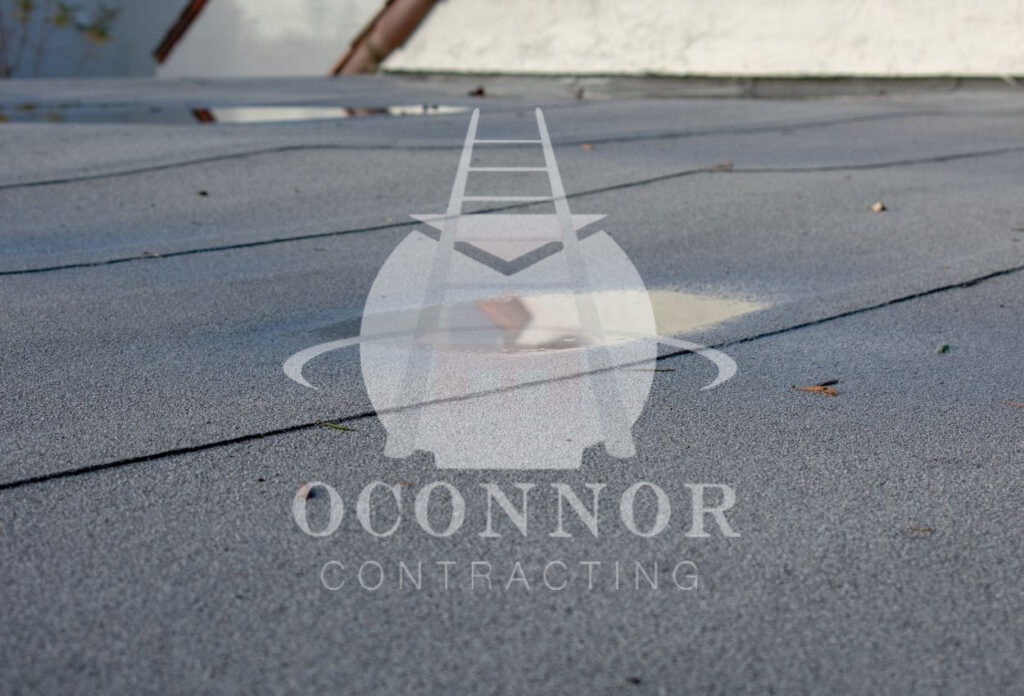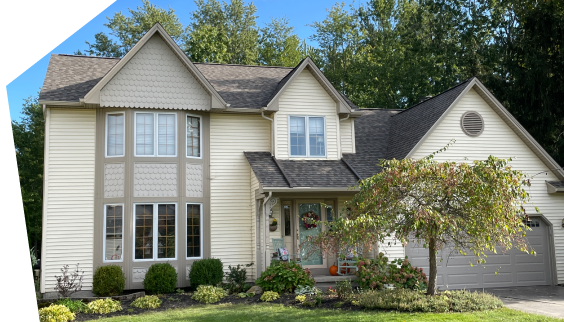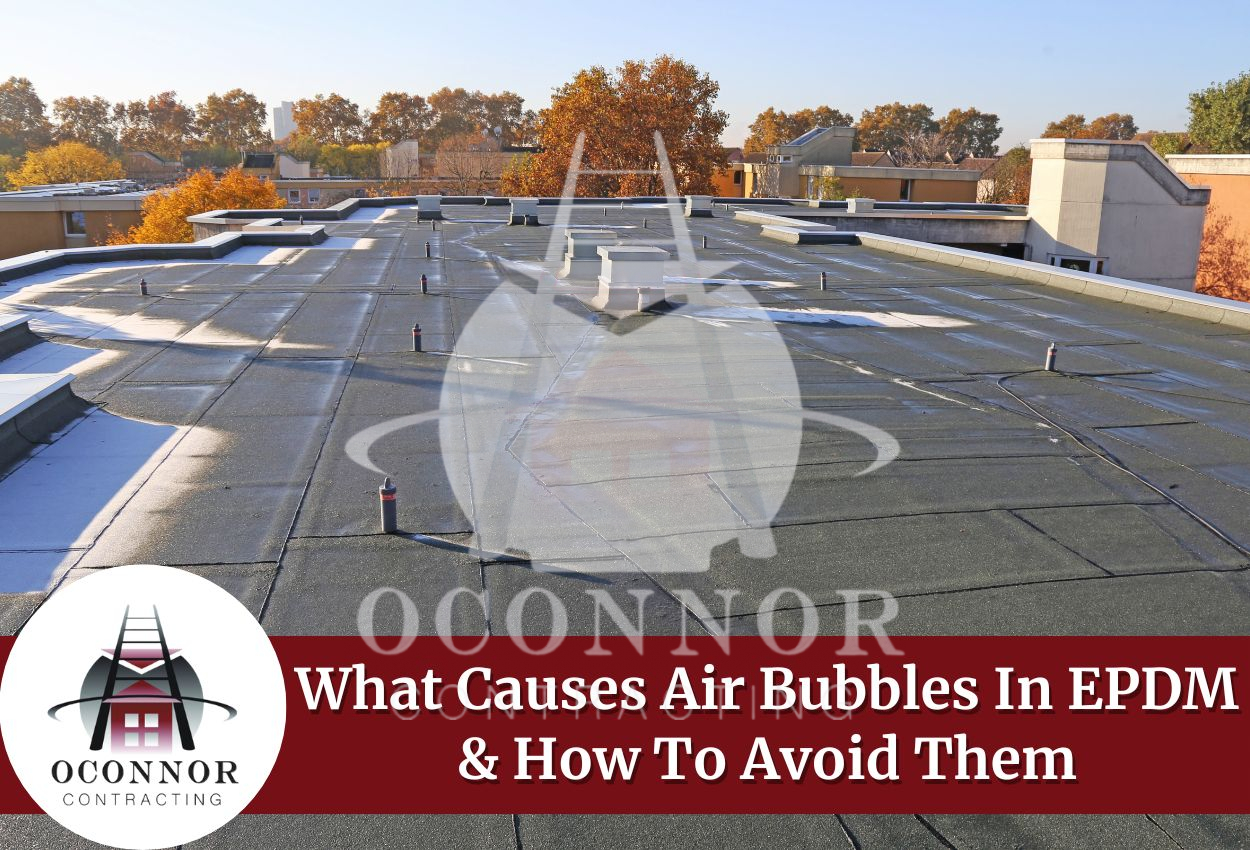Since EPDM (ethylene propylene diene monomer) roofing is affordable, durable, and weather-resistant, it has always been popular in both commercial and residential settings. However, like any other roofing system, it also has its drawbacks. One common issue is the formation of air bubbles beneath the membrane, which can jeopardize the roof’s structural integrity.
To help understand this issue better, this blog post will answer the question, “What causes air bubbles in EPDM?”, and provide practical tips to prevent them.
What is EPDM, and Why Is It Prone to Air Bubbles?
Known for its durability and resistance to extreme weather, UV rays, and ozone degradation, EPDM is commonly used for flat commercial roofs. However, air bubbles can form during installation if the adhesive on the membrane doesn’t bond properly with the surface.
This usually happens when the adhesive is applied unevenly or not given enough time to dry before the EPDM membrane is placed. While roof bubbles may appear as cosmetic issues, they can lead to more serious problems if moisture gets trapped beneath the membrane, potentially causing condensation and long-term damage.

What Does an Air Bubble Look Like on an EPDM Roof?
Bubbles on an EPDM roof appear as raised, dome-shaped areas on the surface, ranging from small pinpricks to larger blisters. These bubbles create an uneven texture and typically match the black or gray color of the EPDM material.
However, they may look slightly lighter or shinier in color due to the trapped air or moisture underneath. The edges of the roof bubbles can be smooth or slightly wrinkled, and they often feel soft or spongy when pressed.
Also Read: EPDM Vs. Duro-Last: A Guide To Their Differences
What Are The Primary Causes of Air Bubbles in EPDM?
Now, let’s take a look at the common causes of air bubbles in EPDM roofs:
#1. Vapors from Contact Adhesive
Air bubbles along EPDM membranes are often caused by vapors from the contact adhesive. Many chemical adhesives release vapors, and if the adhesive isn’t fully dry before applying the membrane, trapped vapors can expand, causing bubbles.
#2. Trapped Air Expansion
Similarly, trapped air beneath the membrane also causes bubbles, especially in warm deck roofing designs. When moisture-laden air is trapped under insulation, it expands with heat, forming bubbles along EPDM seams.
#3. Moisture and Temperature Changes
Temperature fluctuations can further exacerbate this issue. As it warms, trapped moisture creates pressure, leading to bubbles, while cooling at night causes the membrane to contract, weakening the bond over time and allowing more air bubbles to develop.
#4. Improper Installation Practices
Air bubbles are often linked to poor installation practices, such as applying adhesive in damp conditions or not allowing it to cure fully. Ensuring proper curing time and surface preparation can help prevent bubbling.
#5. Aging and Wear
Over time, wear and environmental factors like UV exposure can degrade the EPDM, making it more prone to bubbles. Regular inspections and maintenance will help catch these signs of wear early, before they become worse and lead to replacement.
#6. Inadequate Surface Preparation
The root cause of many issues related to air bubbles along roofing membranes is inadequate surface preparation. If the surface isn’t cleaned or primed properly, contaminants can interfere with the adhesive, trapping air beneath the membrane. This makes it crucial to clean the flat roofing surface prior to installing the membrane.
#7. Incompatible Materials
Finally, using materials not compatible with EPDM, such as certain sealants, can weaken the adhesive bond and create air pockets. Using approved materials ensures a secure, lasting seal.
What Are The Consequences Of Ignoring Air Bubbles?
Let’s take a look at what happens when you ignore air bubbles, and how they can affect your roof:
1. Compromised Structural Integrity
Air bubbles indicate improper installation or trapped moisture, which risks membrane detachment. Over time, these issues may worsen, requiring expensive EPDM roof repair, or even full roof replacement.
2. Risk of Water Intrusion
As air bubbles trap moisture beneath the membrane, the risk of leaks increases. This moisture can cause further damage, such as rot and mold, impacting the underlying materials.
3. Aesthetic Deterioration
While the immediate impact may not affect functionality, visible air bubbles lead to unsightly blisters. This can lower property value and negatively affect tenant satisfaction, signaling neglect.
4. Increased Maintenance Costs
If air bubbles are ignored, the problem can escalate, leading to expensive EPDM roof repairs. Addressing the problem early is more affordable than dealing with significant damage later on.
5. Potential for Membrane Failure
Trapped moisture can degrade roofing materials, increasing the likelihood of membrane failure. Regular maintenance and prompt repairs help prevent this issue and extend the roof’s life.
6. Reduced Energy Efficiency
Air bubbles disrupt the roof’s ability to provide an effective seal, and therefore, insulation. HVAC systems need to work harder to maintain a comfortable temperature, which results in higher energy costs and less efficient performance.
7. Warranty Issues
Many roofing warranties become void if air bubbles are ignored. Without proper maintenance, property owners may be stuck with EPDM repair costs that would otherwise be covered.
8. Safety Hazards
Bubbles can cause uneven surfaces or pooling water, creating slip or trip hazards. Ensuring the roof remains safe for maintenance personnel is essential.
9. Compromised Drainage
Air bubbles block proper drainage, preventing water from flowing off the roof. This can lead to pooling, increasing the likelihood of leaks and more serious damage.
10. Impact on Surrounding Areas
If left unchecked, air bubbles can lead to leaks that affect the surrounding areas, such as walls and insulation. Prompt action prevents costly damage to other parts of the building.
Also Read: TPO Roofing Vs. EPDM: A Comparative Guide
How to Avoid Air Bubbles Along Your EPDM Roof
Let’s explore some key strategies to prevent air bubbles from forming on your EPDM roof:
1. Proper Installation Techniques
Ensuring correct installation is crucial to preventing air bubbles. Using the right adhesives and allowing them to dry properly prevents trapped vapors. This step, combined with professional installation, reduces the risk of bubbles forming in the future.
2. Vapor Management
As part of proper installation, effective vapor management is essential. Adhesives must dry fully in well-ventilated conditions otherwise, trapped vapors can lead to bubbles beneath the membrane. Monitoring environmental conditions ensures adhesives cure correctly and prevents this issue.
3. Moisture Control
Alongside vapor management, controlling moisture is vital. In warm deck designs, trapped moisture can cause bubbles. To prevent this, make sure the insulation fits tightly, filling any gaps where moisture could be trapped under the membrane. This proactive step keeps moisture from compromising the roof.
4. Quality of Materials
Using high-quality EPDM materials further supports the need for moisture and vapor control. Reliable brands ensure better adhesion and withstand environmental stresses, reducing the chances of premature failure and roof bubble formation. With better warranties and performance guarantees, quality materials provide long-term peace of mind as well.
5. Adhesive Application Techniques
To ensure the highest quality installation, applying adhesives correctly is key. Following guidelines for thickness, coverage, and drying time guarantees a consistent bond, minimizing air pockets. Controlling temperature and humidity during application also improves adhesion, reducing the risk of bubbles.
6. Regular Inspections and Maintenance
Even with quality installation, routine inspections are necessary. Regular checks help catch early signs of bubbles, preventing more serious issues. Maintenance, such as cleaning and wear checks, ensures the roof remains free of trapped air and moisture.
7. Temperature Considerations
Designing the roof with proper ventilation and choosing materials that can adapt to temperature changes minimizes the risk of bubble forming.
8. Professional Repair Options
If bubbles do form, quick repairs are crucial. Small bubbles can be fixed by releasing trapped air and reapplying adhesive, while larger bubbles may require more extensive repairs. Consulting professionals ensure repairs are done properly, maintaining the roof’s integrity for the long term.
Protect Your EPDM Roof from Air Bubbles With OConnor Contracting!
Although air bubbles along an EPDM roof are a major problem, they can be prevented with the correct care. The secret to preventing bubbles is to properly prepare the surface, apply the adhesive, and have it professionally installed. The lifespan of your EPDM roof can even be prolonged with timely EPDM repairs and routine maintenance.
For all of your EPDM roofing requirements, OConnor Contracting is the company to choose. We offer EPDM professional installation, maintenance, and repair services with years of experience and a dedication to excellence. Our team of highly qualified experts employs cutting-edge methods to guarantee a long-lasting, waterproof, and energy-efficient roof. Put your trust in us and give us a call at (716) 600-7663 for an instant quote.


